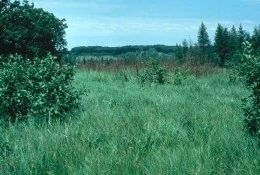Summerton Bog
No. 42

Photo by Dave Warners
Situated in a glacial lakebed with muck and peat soils, Summerton Bog is a highly diverse complex of low meadow, bog, fen, tamarack, and shrub communities. Water is at or near the surface year-round in the lowland areas, supplied by precipitation and five large artesian springs. The earliest maps of the area, dating back to the 1830s, show sedge meadows as the predominant vegetation. Located in the southeastern corner is a five-acre glacial till island wooded with red and white oaks. On the western flank of the island is a calcareous fen. Its calcium-rich waters have allowed an unusual assemblage of plants to thrive including typical fen species bluejoint grass, sweet grass, tussock sedge, spring cress, valerian, fringed gentian, and lousewort.
Forested communities are mostly dominated by tamarack with a few black spruce. Groundlayer species include sundew, pitcher plant, and cranberries. At the southwestern corner is an area of black ash, basswood, and shagbark hickory. The remaining communities are shrub carr and sedge meadow. Poison sumac is abundant throughout the sedge meadow and tamarack bog. Nesting birds include the sandhill crane, sedge wren, Nashville warbler, and veery. Prescribed burns and brushing are conducted to maintain sedge meadow and fen community vigor. Summerton Bog is owned by the Wisconsin Chapter of the Nature Conservancy and was designated a State Natural Area in 1966.
Very few State Natural Areas have public facilities, but nearly all are open for a variety of recreational activities as indicated below. Generally, there are no picnic areas, restrooms, or other developments. Parking lots or designated parking areas are noted on individual SNA pages and maps. If a developed trail is present, it will normally be noted on the SNA map and/or under the Maps tab. A compass and topographic map or a GPS unit are useful tools for exploring larger, isolated SNAs.
The good majority of SNAs are isolated and have few or no facilities. Some SNAs have vehicle access lanes or parking lots, but their accessibility may vary depending on weather conditions. Parking lots and lanes are not plowed during winter. Hiking trails may be nonexistent or consist of undeveloped footpaths. A GPS unit or compass and a detailed topographic map are useful tools for exploring larger SNAs.
Hunting and trapping
For hunting opportunities on Nature Conservancy land, visit The Nature Conservancy's Deer Management [exit DNR].
Allowable activities: DNR-owned land
The activities listed below are generally allowed on all DNR-owned SNA lands. Exceptions to this list of public uses, such as SNAs closed to hunting, are noted above and posted with signs on the property site.
- Hiking
- Fishing
- Cross country skiing
- Hunting
- Trapping
- Scientific research (permit required [PDF])
- Outdoor education
- Wild edibles (What is this?)
- Pets (Rules)
- Wildlife viewing
Prohibited activities: all SNAs
- Camping and campfires
- Collecting of animals (other than legally harvested species), non-edible fungi, rocks, minerals, fossils, archaeological artifacts, soil, downed wood, or any other natural material, alive or dead.
- Collecting for scientific research requires a permit issued by the DNR
- Collecting of plants including seeds, roots or other non-edible parts of herbaceous plants such as wildflowers or grasses
- Geocaching
- Horseback riding
- Rock climbing
- Vehicles, including bicycles, ATVs, aircraft, and snowmobiles except on trails and roadways designated for their use.
For rules governing state-owned SNAs and other state lands, please consult Chapter NR 45 Wis. Admin. Code [exit DNR].
Location
Marquette County. T15N-R8E, Sections 26, 27, 34, 35. 427 acres.
Driving directions
From the intersection of Highways 51 and D, about 3.5 miles north of Endeavor, go west on D for 2 miles, then west on Freedom Road about 1.5 miles to a parking lot south of the road. Bog access is through the old field.
The DNR's state natural areas program is comprised of lands owned by the state, private conservation organizations, municipalities, other governmental agencies, educational institutions and private individuals. While the majority of SNAs are open to the public, access may vary according to individual ownership policies. Public use restrictions may apply due to public safety, or to protect endangered or threatened species or unique natural features. Lands may be temporarily closed due to specific management activities.
Users are encouraged to contact the landowner for more specific details. The data shown on these maps have been obtained from various sources, and are of varying age, reliability, and resolution. The data may contain errors or omissions and should not be interpreted as a legal representation of legal ownership boundaries. To create your custom map where you can zoom to a specific location, please use the DNR's Mapping Application.
Summerton Bog is owned by: The Nature Conservancy
